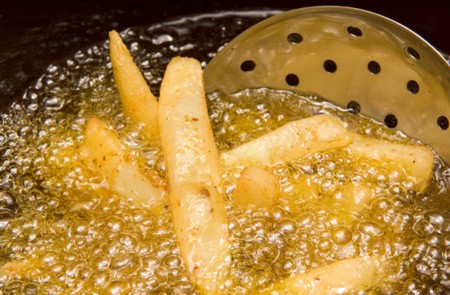So, I read this online article recently about how you can make fried foods healthier, see? And I got to thinking, isn’t this all, pretty much, common sense? And I asked myself if part of the problem with people not eating healthfully these days has more to do with lack of knowledge than lack of caring or lack of money…
There are several factors to consider when judging the healthiness of any food product or recipe.
Fat type
Almost all foods have some fat content, whether its animal- or vegetable-source fat. In their natural form (liquid), veggie fats like Canola, Corn and Olive Oil are quire healthy, inasmuch as they contain mainly healthy fats (good for your choesterol). When you treat them with hydrogen and other stuff to make them hard or spreadable (margarine) they’re less healthy. But you probably already knew that. On the other hand, we all need some animal fat in our diets, and the vitamins and other nutrients they bring us. The alternative is taking supplements, which isn’t nearly as much fun as eating a steak. Just remember: Too much fat of any kind, or total fats in your diet, is going to be bad for you, in the end. Calories from fat are more likely to be stored as fat in your system than calories from protein.
Fat Content
Fat content is sigificantly higher in most processed foods than in foods you prepare at home. In fact, manufacturers have to muse ingredients that you’d never use at home to make their mechanized mega-manufacturing processes work properly. The formulas must not be too thin or too thick, to dry or too sticky to run smoothly through the dies, extruders, rollers, depositors and other devices that churn out millions of granola bars, pizza puffs, chicken pot pies, cupcakes, loaves of bread and rolls, egg rolls, breakfast cerials or thousands other products a day. You’ll never even see most of the ingredients on the average processed food product in a grocery store, come to think of it. Food manufacturing companies say these foods are designed for your convenience. But their own convenience, on the production line, comes first.
Overall, manufacturers use ingredients in their p[rocesses that lack flkavour, colour and texture. that’s why they have to add colour back in, via artificial dyes, and texture, via ‘texturizing protiens’. And its also why they add so much sugar, salt and fat – to make up for lost flavour.
Portion size
…But make that a small steak, and a lean cut. Unfortunately, the healthiest cuts off of a cow are the most expensive. I like a nicely-marbled Rib Eye or Strip Loin. Very little edge fat, there.Other cuts have less fat but are less flavourful and tougher. That’s where marinating and mechanical tenderizing come in. The lesson to take away here is that a 6 oz. boneless fillet is not only more satisfying, less fatty and easier to eat than that 16 oz. T-Bone – it’s probably cheaper, after you take into account the weight in bone and cap fat which gets tossed, but which you pay for at the same premium price per pound. And remember: The dieticians say one serving of meat should equal the size of a deck of playing cards, or, just enough to cover the palm of your hand. In the real world, nobody eats that little meat, unless they’re having a 2 in. Filet Mignon or they’re having a quater-pound or smaller burger. But the burger is problematic, fat-wise, because it’s almost always accompanied by Fries, which are among the worst offenders for hoarding fat during cooking.
Fat = Flavour
That’s an old Chef’s maxim and it’s true, to a point. That’s why the nicely-marbled Rib Eye is tastier than the ultra-lean Sirloin. But too much fat in the pan, or deep-frying to excess, can both be a problem. You’ll know when you have too much fat in or on your food: You’ll taste the fat, not the flavour of the food, itself, first.
And, as usual, let common sense and moderation be your guide when judging foods for fat content. Fries once a week won’t hurt you. On the other hand, eating a whole bowl of frosting is not recommended – for oh, so many reasons!
~ Maggie J.

